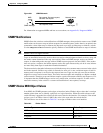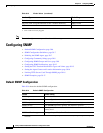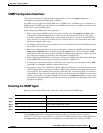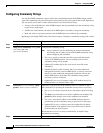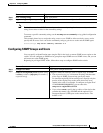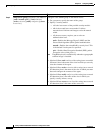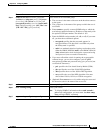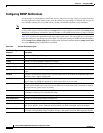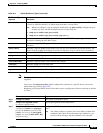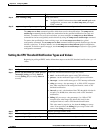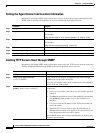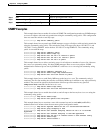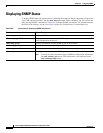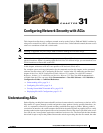
30-13
Catalyst 2960 and 2960-S Switch Software Configuration Guide
OL-8603-09
Chapter 30 Configuring SNMP
Configuring SNMP
Note Though visible in the command-line help strings, the insertion, and removal keywords are not
supported.
You can use the snmp-server host global configuration command to a specific host to receive the
notification types listed in Table 30-5.
Beginning in privileged EXEC mode, follow these steps to configure the switch to send traps or informs
to a host:
port-security Generates SNMP port security traps. You can also set a maximum trap rate per second. The range
is from 0 to 1000; the default is 0, which means that there is no rate limit.
Note When you configure a trap by using the notification type port-security, configure the port
security trap first, and then configure the port security trap rate:
• snmp-server enable traps port-security
• snmp-server enable traps port-security trap-rate rate
rtr Generates a trap for the SNMP Response Time Reporter (RTR). This trap is supported only when
the switch is running the LAN Base image.
snmp Generates a trap for SNMP-type notifications for authentication, cold start, warm start, link up or
link down.
storm-control Generates a trap for SNMP storm-control. You can also set a maximum trap rate per minute. The
range is from 0 to 1000; the default is 0 (no limit is imposed; a trap is sent at every occurrence).
stpx Generates SNMP STP Extended MIB traps.
syslog Generates SNMP syslog traps.
tty Generates a trap for TCP connections. This trap is enabled by default.
vlan-membership Generates a trap for SNMP VLAN membership changes.
vlancreate Generates SNMP VLAN created traps.
vlandelete Generates SNMP VLAN deleted traps.
vtp Generates a trap for VLAN Trunking Protocol (VTP) changes.
Table 30-5 Switch Notification Types (continued)
Notification Type
Keyword Description
Command Purpose
Step 1
configure terminal Enter global configuration mode.
Step 2
snmp-server engineID remote
ip-address engineid-string
Specify the engine ID for the remote host.
Step 3
snmp-server user username
groupname {remote host [udp-port
port]} {v1 [access access-list] | v2c
[access access-list] | v3 [encrypted]
[access access-list] [auth {md5 | sha}
auth-password]}
Configure an SNMP user to be associated with the remote host created in
Step 2.
Note You cannot configure a remote user for an address without first
configuring the engine ID for the remote host. Otherwise, you
receive an error message, and the command is not executed.



